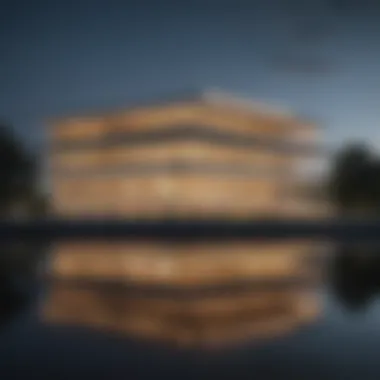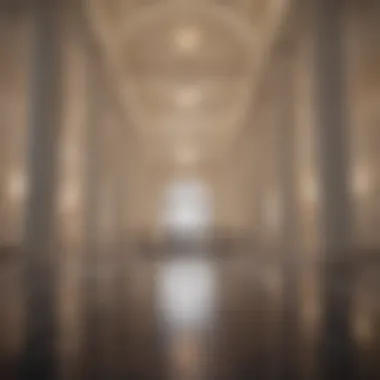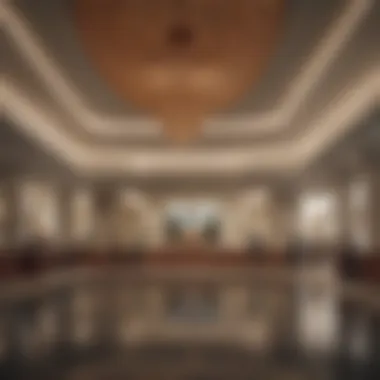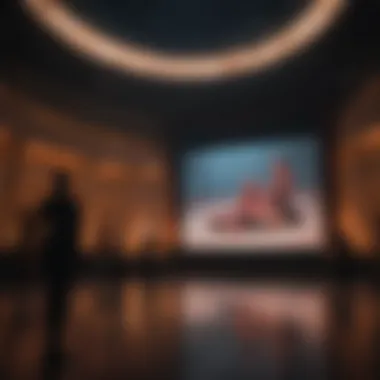Exploring the Kennedy Center: A Cultural Landmark


Intro
The Kennedy Center, located in Washington, D.C., is a benchmark of American culture and a universal canvas for artistic expression. This venue is not merely a framework of concrete and glass; it embodies the spirit of art in its many forms. As one of the most renowned performing arts centers, it serves as a platform for countless national and international talents. As we journey through this cultural landmark, we will explore its exquisite architecture, historical significance, and the various artistic offerings it presents. Understanding these facets reveals not just what the Kennedy Center is, but why it holds a unique place in the hearts of so many.
Exquisite Architectural Designs
The Kennedy Center is celebrated for its distinct architectural style. Its design integrates functionality with elegance, making it not only a place for performances but also a visual delight.
Unique Home Features
The building itself showcases a modernist approach while incorporating classical elements through its facade and interior spaces. It features a grand marble foyer, expansive concert halls, and intimate performance venues. The seating arrangements are designed to ensure that every visitor has an unobstructed view of the stage. Furthermore, the terrace offers a stunning view of the Potomac River, adding to the overall experience of the location.
Historical Significance
Construction of the Kennedy Center began in 1971, and it was officially opened in 1971 by President Richard Nixon. Named after John F. Kennedy, the center aspires to embody his commitment to the arts. Over the years, it has hosted an array of events which illustrate its role in enriching the cultural landscape of America. The Kennedy Center is also home to the National Symphony Orchestra, the Washington National Opera, and the Suzanne Farrell Ballet. Each of these artistic groups contributes to the cultural tapestry that the center represents.
"The Kennedy Center is not just a venue; it is a symbol of American artistry and innovation."
As we delve deeper into this remarkable establishment, we will further examine the offerings and community engagement that make the Kennedy Center a vital cultural hub.
Preamble to the Kennedy Center
The Kennedy Center embodies a paramount cultural framework in the United States. This institution is not merely a venue for performing arts; it stands as a reflection of American artistic expressions and values. A deep dive into its aspects reveals its significance beyond performances. This section highlights the origin and establishment of the Center, as well as its mission and vision. Understanding these foundational points provides crucial insight into the cultural importance of the Kennedy Center.
Origin and Establishment
The conception of the Kennedy Center traces its roots to the early 20th century, amidst an American landscape rich in artistic potential. Named in honor of President John F. Kennedy, it was established through an act of Congress in 1965. The aim was clear: to create a national cultural center that celebrates the performing arts. Initially, plans faced various bureaucratic challenges, but persistent advocates helped bring this vision to fruition.
Construction began in 1970 and was completed in 1971. The Center opened its doors with a mission to not only host cultural events but also to foster education in the arts. It quickly became home to the National Symphony Orchestra, the Washington National Opera, and other elite performing companies. Since then, the Kennedy Center has evolved, adapting to changes in the cultural landscape while maintaining its commitment to excellence.
Mission and Vision
The Kennedy Center articulates its mission as promoting the performing arts for all. This commitment resonates through their diverse programming, incorporating both established and emerging artists. The vision revolves around the belief that the arts can bridge divides and inspires future generations. This forward-thinking approach reflects a broader trend in cultural institutions aiming to engage a more inclusive audience.
Key principles of the Kennedy Center's mission include:
- Cultural Preservation: Upholding the rich legacy of American culture through performances and educational efforts.
- Artistic Innovation: Encouraging new works and collaborations that challenge traditional boundaries.
- Community Engagement: Actively seeking to connect with wider communities through outreach and accessibility programs.


The Kennedy Center's foundational purpose reinforces its status as a cultural beacon, inspiring both locals and visitors alike to engage with the arts in meaningful ways.
Architectural Design
Architectural design plays a crucial role in shaping the identity and experience of the Kennedy Center. This cultural landmark, with its striking visual appeal, reflects both artistic ambition and practical considerations. The interplay of aesthetics and functionality in its design has made the Kennedy Center not only a venue for performances but also a work of art in itself.
Influence of Modernism
Modernism is a significant influence on the architectural approach seen in the Kennedy Center. The design ethos is characterized by simplicity and a rejection of ornate detail. This results in clean lines and open spaces that invite exploration. The space showcases a blend of innovative materials, which promotes a sense of transparency and lightness.
The architects also focused on harmonizing the structure with the surrounding environment. The use of concrete and glass helps to provide a contemporary feel, while large windows allow natural light to penetrate and enhance the atmosphere inside. Modernism at the Kennedy Center represents a shift away from traditional performance venues, encouraging new forms of artistic expression.
Exterior Features
The exterior of the Kennedy Center is notable for its bold design choices. The grand entrance features a wide staircase that leads to a prominent portico, creating an inviting atmosphere. The facade is primarily clad in white concrete, which reflects sunlight, giving the building a dynamic appearance throughout the day.
Other exterior elements of significance include the bronze sculptures that grace the entrance area. These artworks serve as a bridge between the building and its artistic mission, embodying the spirit of performance. Surrounding the center, the landscaping also plays an important role, with green spaces that allow visitors to enjoy a moment of tranquility before entering the vibrant world of the performing arts.
Interior Space Planning
The interior design of the Kennedy Center is meticulously planned to enhance both functionality and aesthetic appeal. The layout facilitates easy navigation, with clearly defined spaces for different activities. Each theater within the center is designed with acoustics in mind, ensuring that the experience of performances is optimized for audiences.
The interiors feature a mix of warm materials and colors. This thoughtful choice contributes to a welcoming ambiance, making visitors feel at ease. Additionally, there are lounges and meeting spaces that encourage social interaction among patrons.
Moreover, by integrating art installations throughout the building, the space itself becomes a gallery where art and performance coexist. This interaction enriches the visitor experience and emphasizes the Kennedy Center's role as a cultural hub.
"The architectural elements of the Kennedy Center not only serve a functional purpose but also inspire creativity and dialogue among artists and audiences alike."
In summary, the architectural design of the Kennedy Center is integral to its identity as a cultural landmark. The influences of modernism, combined with carefully considered exterior and interior features, create a space that is both inviting and inspiring. It reflects the spirit of performing arts in America, making it a vital part of the cultural landscape.
Cultural Significance
The cultural significance of the Kennedy Center extends beyond its grandeur and architectural marvel. It serves as a vital hub for the performing arts, facilitating a diverse range of artistic expressions that resonate with various audiences. As a national monument, it reflects American traditions while also embracing contemporary movements in the arts. The center not only showcases performances but also contributes to the enrichment of the cultural tapestry that shapes American identity. Its role as the National Center for the Performing Arts highlights its commitment to promoting artistic excellence and accessibility.
National Center for the Performing Arts
The Kennedy Center stands as the National Center for the Performing Arts, an epitome of cultural dedication in the heart of Washington, D.C. In this capacity, it hosts an impressive array of performances that encompass music, dance, theater, and more. Institutions like the National Symphony Orchestra and the Washington National Opera have made the Kennedy Center their home. These entities benefit from the center's resources and reach, giving them a platform to present their work both to local and international audiences. The Kennedy Center helps cultivate not just established artists but also budding talent, encouraging a vibrant arts scene.
Performances at the Kennedy Center enhance cultural discourse, as they often reflect the societal issues and themes that shape modern life. Notable events, such as the Kennedy Center Honors, celebrate the contributions of influential artists while raising awareness about the arts' importance in society. Attendance at these performances fosters community, as diverse groups gather to appreciate and engage with the arts.


Influence on American Culture
The impact of the Kennedy Center on American culture cannot be overstated. It acts as a custodian of artistic expression, shaping how Americans interact with the arts. By highlighting both historical and contemporary artists, the center educates visitors about the evolution of various art forms. Its programming often includes a wide range of genres, promoting understanding and appreciation of different cultures and perspectives.
One significant aspect of its cultural influence is the emphasis on inclusivity. The Kennedy Center strives to ensure that the arts are accessible to everyone, regardless of background or economic status. Programs such as free outdoor performances and community outreach initiatives enable wider participation. Additionally, the artistic collaborations that take place within its walls often lead to innovative works that speak to the current moment while addressing timeless human experiences.
"The Kennedy Center is not just a venue for performances. It represents a collective celebration of artistry and cultural exchange that enriches us as a society."
In summary, the Kennedy Center’s cultural significance lies in its multifaceted role as a beacon of the performing arts. It nurtures artistic talent, engages with communities, and fosters a deeper understanding of American culture through a rich and diverse array of performances.
Artistic Offerings
The Kennedy Center serves as a pivotal nexus of artistic expression, where various forms of performance art converge. Within its esteemed walls, visitors are treated to a rich tapestry of cultural offerings that span multiple disciplines, including theater, music, and dance. These artistic offerings not only entertain but also foster a deeper appreciation and understanding of diverse artistic traditions.
Performing Arts: A Diverse Spectrum
At the heart of the Kennedy Center's identity is its commitment to showcasing a variety of performing arts. This diversity is evident in the range of productions that grace its stages. From classical music concerts by the National Symphony Orchestra to innovative theatrical performances by resident companies, there is something for everyone.
- Theater: The Kennedy Center regularly features plays, musicals, and operas. These productions often highlight both contemporary and classical works, allowing audiences to engage with various narratives and performances.
- Dance: The institution is also home to a multitude of dance performances. Renowned dance companies often perform, representing different styles and cultural backgrounds. This exposure fosters a deeper understanding of the art form and its cultural significance.
- Music: The musical offerings at the Kennedy Center include genres ranging from jazz to orchestral compositions. Special concerts often feature acclaimed musicians and composers, enriching the cultural fabric of the experience.
These offerings contribute significantly to the cultural landscape of Washington, D.C., while also enhancing community participation in the arts. The Kennedy Center's role as a platform for diverse artistic expression cannot be overstated.
Annual Festivals and Events
The Kennedy Center hosts a variety of annual festivals and events that further emphasize its commitment to the arts. These celebrations often attract thousands of attendees, creating a vibrant atmosphere.
- The Kennedy Center Honors: This prestigious event celebrates individuals who have made significant contributions to the performing arts. It serves not only to recognize these artists but also to inspire emerging talents.
- The American Film Institute (AFI) Docs Festival: This event showcases documentary films that engage with important contemporary issues. The festival attracts filmmakers and audiences alike, fostering dialogue through cinema.
- Specific Cultural Festivals: Events like the celebration of the National Asian Pacific American Heritage Month highlight the center's dedication to cultural diversity. Such festivals include performances, discussions, and educational activities that enrich the community's understanding of different cultures.
Each of these festivals presents an opportunity for the public to engage with the arts in meaningful ways. They draw diverse audiences together, reinforcing the Kennedy Center's role as a community hub and cultural beacon.
Visitor Experience
The visitor experience at the Kennedy Center is a vital aspect that enhances its reputation as a premier cultural hub. This experience shapes how individuals perceive the artistic offerings and the overall atmosphere of the institution. It involves facets such as accessibility, educational opportunities, and the various amenities provided for patrons. A well-designed visitor experience elevates more than just a visit; it transforms it into a memorable journey that fosters appreciation for the arts.
Access and Transportation
Access to the Kennedy Center is crucial for its visitors. Located at 2700 F Street NW in Washington, D.C., it's essential to note the transportation options available. The center can be approached using various means, including public transport. The nearby Foggy Bottom-GWU Metro Station connects visitors to the broader metro network, facilitating easy access from different parts of the city. Furthermore, the center is accessible by bus, with several lines stopping close by.


For those choosing to drive, there is ample parking available, although it is important to consider peak event times when spaces may become limited. Ride-share services are also prevalent in the area, offering a practical and convenient option for travelers without a personal vehicle. Adapting to multiple transport methods ensures that all visitors can arrive effortlessly, setting a welcoming tone right from the start.
The accessibility extends beyond transport itself. The Kennedy Center caters to individuals with disabilities, providing accessible design features throughout the facility. Wheelchair access and designated seating areas enhance the experience for all patrons, demonstrating the center’s commitment to inclusivity.
Educational Programs and Tours
Educational programs and tours at the Kennedy Center play a significant role in enriching the visitor experience. These programs attract various audiences, including students, families, and art enthusiasts. They offer insights into the creative process and history of performances, helping visitors to connect more deeply with the arts.
Tours of the Kennedy Center are structured to guide visitors through its hallmarks. These tours allow guests to explore behind-the-scenes areas, such as rehearsal spaces and stages, often highlighting the vibrant history of performances that have taken place there. Attending these guided experiences enhances the appreciation for the architecture and artistic legacy, making the visit both informative and engaging.
Educational initiatives also include workshops and interactive sessions led by experienced artists and educators. Such activities encourage participation and creativity, particularly among young visitors, fostering a passion for the performing arts.
In summary, the visitor experience at the Kennedy Center goes beyond just attending performances. Access and transport are made easy and accessible for everyone. Additionally, educational programs create enriched visits that spark creativity and appreciation. With these components, the Kennedy Center stands as a beacon of culture and arts, inviting all to engage and learn.
Community Engagement
Community engagement forms a crucial aspect of the Kennedy Center's mission. It reflects the center's dedication to social responsibility and cultural inclusiveness. By actively involving the community, the Kennedy Center not only presents performances but also fosters relationships with diverse groups and individuals. This engagement enhances the cultural landscape and brings a sense of ownership and pride to the community surrounding this iconic venue.
Outreach Initiatives
The Kennedy Center implements various outreach initiatives aimed at making the arts accessible to a broader audience. These programs focus on bridging gaps in access to cultural experiences, especially for underserved populations. Through workshops, public performances, and community events, the center reaches individuals who might otherwise be excluded from such enriching experiences due to economic or geographic barriers.
- Educational Workshops: The Kennedy Center organizes workshops for schools and community groups. These sessions often involve hands-on activities that introduce participants to different aspects of the performing arts.
- Free Performances: The center hosts free or low-cost performances, making it possible for families and individuals from various backgrounds to attend.
- Partnerships with Local Organizations: By collaborating with local nonprofits and schools, the Kennedy Center enhances its outreach, targeting specific communities to encourage participation.
Support for Emerging Artists
Supporting emerging artists is a vital component of the Kennedy Center’s community engagement strategy. By providing resources and platforms for new talent, the center nurtures the next generation of performers and creators. This aspect underscores the commitment to fostering a vibrant cultural ecosystem that thrives on innovation and diversity.
- Residency Programs: The Kennedy Center often runs residency programs that allow emerging artists to develop their work in a supportive environment. Artists gain access to rehearsal space, mentorship, and professional development resources.
- Showcasing New Work: Regularly scheduled events showcase new works from debuting artists. This not only helps those artists gain visibility but also enriches the overall cultural offerings at the center.
- Collaboration with Educational Institutions: In partnership with local colleges and universities, the center facilitates performance opportunities for students. These collaborations provide real-world experience and help students transition into the professional arts community.
"The Kennedy Center plays a pivotal role in shaping the future of performing arts by nurturing emerging talent and engaging the community."
The End: A Cultural Beacon
The Kennedy Center serves as a vital and dynamic cultural beacon within the American artistic landscape. Its significance extends beyond mere architecture; it encapsulates a commitment to fostering creativity, promoting diverse artistic expressions, and engaging with the community. The Center not only hosts performances but also offers educational programs and outreach initiatives that enrich public understanding of the arts. This makes the Kennedy Center not just a venue, but a thriving hub of cultural exchange and artistic growth.
Future of the Kennedy Center
The future of the Kennedy Center appears promising, as it continues to adapt to the shifting dynamics of culture and society. Planned expansions and initiatives aim to enhance visitor experiences and support emerging artists. Collaborations with global institutions reflect a dedication to international dialogue through the arts. As new technologies evolve, the Kennedy Center is likely to integrate digital mediums into performances, ensuring connectivity and inclusivity. This continual evolution highlights the Center's role in not just preserving but also innovating within the arts. Its enduring legacy is predicated on adaptability, ensuring it remains relevant for generations to come.
Invitation to Experience
Visitors to the Kennedy Center are encouraged to immerse themselves in its plethora of offerings. With a diverse range of performances, from symphonies to contemporary dance, there is something for everyone. Guided tours provide insights into both its architectural marvels and its historical journey. Such experiences allow individuals to appreciate the depth of talent showcased within its walls. An invitation to engage with the Kennedy Center means not only attending performances but also participating in educational opportunities. It beckons all—enthusiasts of art, culture, and history—to come and explore what this landmark has to offer.
The Kennedy Center is more than a performing arts venue; it is a vibrant community space that reflects the best of American culture.















